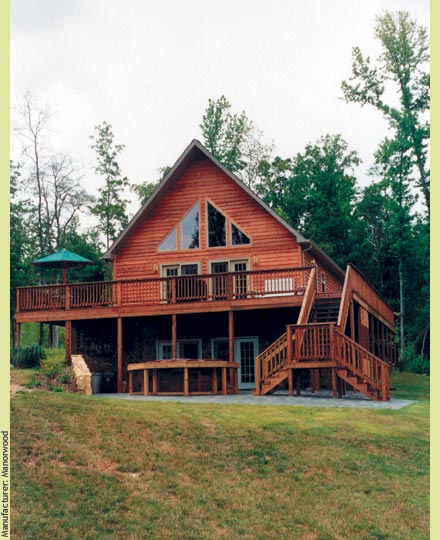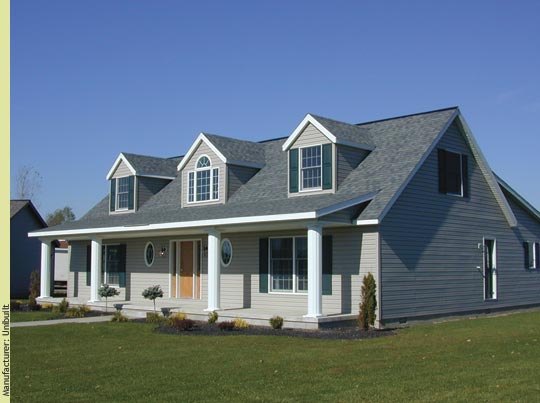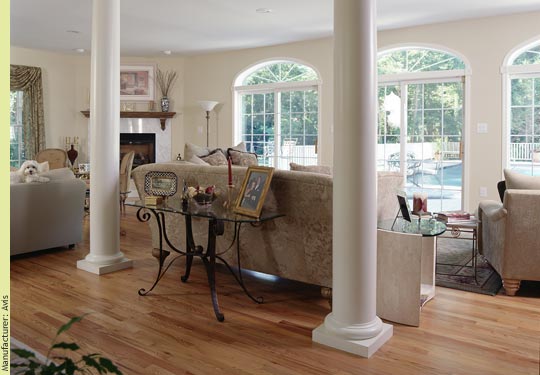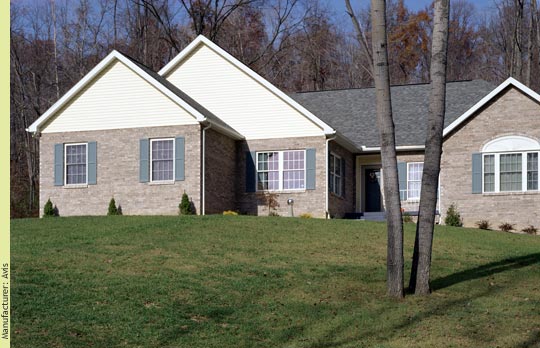|
A brief summary of Chapter 11 "Building on Schedule" (20 pages) in The Modular Home, by Andrew Gianino, President of The Home Store Building your home on schedule takes every bit as much planning as building it on budget. In fact, if you put a lot of effort into planning both, you are likely to find that keeping on schedule is considerably harder than staying on budget. That is because you can determine what you will get and how much you will spend before construction begins, and almost all of the required decisions for building a modular home are reasonably predictable and within your control. This is not true for scheduling, since there are so many other players involved who will not always bend to your will, including the surveyor, engineer, utility company, building inspector, dealer, manufacturer, and general contractor. You may even find that your own personal and family obligations become an obstacle to maintaining your schedule. As you will see, there are two very separable timelines when building a modular home. The first includes all of the tasks you, the dealer, the manufacturer, and the GC need to complete before your home is set. You are primarily responsible for making final decisions about your modular and general contracting drawings and specifications and for completing those tasks related to obtaining a building permit and financing. The second timeline involves those tasks the GC needs to complete after your house is set. This chapter will attempt to identify all of the players, the tasks they must complete, and the sequence in which the tasks should be done. It will also explain your responsibility for completing each of the tasks. Most people building a new home are prepared for the construction to take longer than planned. They have heard that subcontractors, inclement weather, utility companies, and inspection officials all contribute to delays. Few people, however, anticipate how long it takes to complete those tasks that must be done before they begin construction. Consequently, they budget too little time for these tasks and then try to compensate by skipping some tasks and rushing through others. When this strategy fails, they miss their desired move-in date and pay for it with stress with their family, conflict with their dealer and GC, and cost overruns with their budget. It can take you as little as five weeks or as much as a year or more to complete all of the tasks that must be done before your modular home is delivered. Your responsibilities can take as little as one day, if you order a standard modular plan with no changes, select only standard features, agree all decisions are final, have cash to pay for everything, have a GC lined up and ready to go, and have a building permit in hand or don't need one. If this is true for you, you will be an exception. 
A classic Chalet with stained cedar siding creates a vacation retreat
More likely, you will want to customize your modular and GC drawings and specifications, require some time to consider your decisions, and need to wait for the lender to approve your loan and the building department to issue your permit. You may even want to revise your drawings and specifications two or more times. Consequently, you will likely need several weeks before you are done with your responsibilities. Even if you are able to make final decisions about your drawings and specifications in one week, the manufacturer cannot build your home, and you do not want the manufacturer to build your home, until you have obtained a building permit and secured financing. These tasks can take a couple of months. Closing on a construction loan often takes six to eight weeks, completing the preliminary steps required to apply for a building permit can sometimes take several weeks, and receiving a building permit after submitting the application can take up to 30 days. One of the most important variables affecting whether you will be done on time is how quickly you begin your efforts. If you wait two weeks, you will not be able to make up the time by asking your dealer, GC, lender, or building department to work faster. The start of your schedule will also be extended if you have not completed all of the following tasks before you order your home, if you need them done:
-
Secured a building lot or will purchase one immediately
-
Surveyed your building lot
-
Resolved any deed and zoning issues with your building lot
-
Resolved any wetland issues with your building lot
-
Obtained a valid perc test and at least applied for a engineered septic design
-
Selected a GC and/or subcontractors
Once you complete your responsibilities, the manufacturer will need a minimum of five weeks to complete its tasks. The manufacturer typically requires at least three weeks to complete your production drawings and order your materials, one week to build your home, and one week to get it ready for shipment - for a total of five weeks from the date you are ready. It does not matter whether you complete your responsibilities in one day or one year, the typical manufacturer still needs a minimum of five weeks. Furthermore, if you select materials that need to be "special ordered" or are "back-ordered", the manufacturer will need even more time. And if the manufacturer is enjoying a sales boom, which is common today, its backlog of orders can add weeks to its schedule and your delivery date. The following section of this chapter helps you understand the sequence of steps you must complete from the time you order a modular home until it is built and ready for occupancy. It organizes the following dealer, financing, permit, and preconstruction tasks steps into fifteen phases and spells out your responsibilities for each phase in detail:
-
Your Modular Dealer and Financing Tasks
-
Sign a contract with the modular dealer
-
Apply for financing
-
Receive the dealer's first draft of the modular preliminary plans and specifications
-
Meet with the dealer to revise the modular plans and specifications
-
Specify where the GC wants to locate the electrical meter on the modular home
-
Design the second story floor plan for the unfinished cape or attic
-
Tell the dealer what special building codes are enforced by the building department
-
Tell the dealer what matching materials the GC needs to complete the site-built structures
-
Tell the dealer what rough openings the GC wants framed in the modular home
-
Tell the dealer what site-installed flooring and baseboard specifications the GC wants for the modular home
-
Receive the dealer's second draft of the modular preliminary plans and specifications
-
Meet with the dealer to sign off on the plans and specifications
-
Authorize the dealer to complete the modular permit plans
-
Pay the dealer the balance of the required deposit
-
Receive the dealer's modular permit plans
-
Deliver a copy of the bank's commitment letter to the dealer
-
Deliver a copy of the building permit to the dealer
-
Deliver the bank's assignment of funds letter to the dealer
-
Authorize the dealer to build the modular home
-
Send the dealer a certificate of insurance
-
Pay the dealer the modular balance due in full
-
Remain present during the delivery and set
-
Complete a walk-through inspection for warranty work and material shortages

Three gable dormers crown a classic porch
-
Your Permit and Preconstruction Tasks
-
Sign a contract with the GC or separate contracts with the subcontractors
-
Submit the septic design for approval to the board of health
-
Order the land boundary stakes for the property
-
Info rm the GC of any easements or deed restrictions that apply to the property
-
Review any zoning regulations that apply to the property with the building inspector
-
Ask the building inspector if he enforces any special local building codes
-
Determine the cost of all permit fees that apply to the property
-
Give the building permit application to the GC to fill out
-
Ask the GC where he wants to locate the electrical panel box on the modular home
-
Ask the GC to help design the second story floor plan for the unfinished cape or attic
-
Ask the GC to specify the matching materials he needs to complete the site-built structures
-
Ask the GC to specify the rough openings he wants for the modular home
-
Ask the GC to specify the site-installed flooring details for the modular home
-
Receive the GC's first draft of the preliminary plans and specifications
-
Get back the completed permit application from the GC
-
Obtain the necessary signatures on the building permit application
-
Have the surveyor complete the boundary stakes on the property
-
Receive the septic design approval from the board of health
-
Meet with the GC to revise the GC plans and specifications
-
Receive the GC's second draft of the plans and specifications
-
Meet with the GC to sign off on the plans and specifications
-
Ensure the GC drills the well
-
Authorize the GC to draw the permit plans
-
Pay the GC the balance of the required deposit
-
Receive the dealer's GC permit plans
-
Submit the well water test results to the board of health for approval
-
Apply for the building permit
-
Receive the building permit
-
Authorize the GC to begin his work
-
Meet with the GC, his excavator, and the dealer on the site
-
Ensure the GC begins the site work and prepares the site for delivery and set
-
Schedule the surveyor to complete the as-built plan
-
Schedule a bulldozer and/or tow-truck
-
Ensure the GC installs the foundation
-
Locate a staging area to store modules
-
Obtain the as-built plan and get a copy to the bank or town
-
Ensure the GC completes his site and foundation preparation
-
Ensure the GC brings the necessary heavy equipment to both the delivery and set
-
Pay the GC for his excavation and foundation work
Your GC is responsible for meeting two construction schedules. The first, the pre-set schedule, includes those tasks he must complete to have your site and foundation ready for the delivery and set of your modular home. The second, the post-set schedule, involves those tasks he must do to complete the excavation on your property, button-up your home, and build your site-built structures. Before beginning his construction work, the GC should have a preconstruction meeting with you. Even when a construction project goes well it can be stressful to all concerned. It is not just that contractors have a habit of promising too much and delivering too little. It is also that customers without prior building experience have no idea what to expect. A wise GC helps his customers with their inexperience by preparing them for what is to come. With modular-home construction, the greatest potential source of stress is with the GC tasks. The GC can help you have a more prepared, relaxed, and trusting experience by spending an hour or two with you in a preconstruction meeting. Ideally, you will have this meeting about a week or two before the GC begins his pre-set work. 
Classic Greek columns create a generous living room
The GC should address the following questions at the preconstruction meeting:
-
Who is your primary contact and what communications should you have with the GC's other employees and subcontractors?
-
How frequently will your GC speak with you?
-
What you should you do when you want to make a change to your contract?
-
What tentative scheduling plans does the GC have for your project?
-
What factors could contribute to delays (this chapter provides a good overview of typical construction delays)?
-
What scheduling situations might arise that could lead to misunderstandings and ill feelings between you and your GC?
-
What is your GC's responsibility for coordinating any subcontractors you have hired?
-
What tasks are you responsible for even if you hare hired your GC to do "everything", and when should they be done?
-
How will change orders impact on your GC's schedule?
-
What are your GC's expectations for disbursement payments?
-
Can you move in before the GC is done with his contract?
-
Can you move in some of your furniture before the GC is done with his contract?
-
When will the GC complete his walk-through with you and what does he plan to accomplish during it?
-
How will the GC handle the security of your home while work is being completed and will you need to rekey your home before you move in?
-
What is an acceptable hold back for punch list items?
As a way of illustrating how the construction schedule works on a modular home, this chapter presents a timeline for a typical ranch-style home with a site-built, attached two-car garage and a rear deck. It lists each of the pre-set and post-set tasks that must be done. It also lists some additional tasks that must be completed for a raised ranch, Cape Cod, or two-story design. Some of the tasks listed in this chapter must be done in a particular sequence, while many others can be completed in a different order. In construction, those tasks that must be done in a particular order define what is called the "critical path." An example of a task that must be done in a particular sequence is the electrician's wiring of the heating system before the HVAC contractor can fire up the system. An example of a task that can be done at any time is the installation of the bathroom vent fans. The GC will use his professional experience to determine a sequence that works best for him. He will likely change the sequence from project to project depending upon the availability of his employees, subcontractors, and materials. If any delays occur, he will adjust the schedule accordingly. Although the GC can complete the following four tasks when he chooses, it is best if he completes them as soon as possible after the set:
-
Bring electrical power to the house
-
Pour the basement floor
-
Facilitate access to the basement
-
Hookup the heating system
In addition to explaining why completing these four tasks right away can help your GC stay on schedule, this chapter gives advice on sequencing several other tasks, such air sealing, bolting and strapping of the interior marriage wall, drywall work, and siding installation. There are a few factors that can lengthen the GC's pre-set schedule. The GC's start date must be advanced if you need a well drilled before you can receive a building permit. The GC also needs to start earlier if you have a relatively complicated property requiring a lot of site work, such as a complex septic system, a long driveway, blasting of stone or ledge, extensive wetlands remediation, truckloads of additional fill, or extensive grading. Starting earlier enables the GC to complete the additional site work before your home is set. If the foundation is ready for the scheduled delivery date, his additional site work should not delay your move-in date. But it might not be practical for him to complete all of the additional site work in advance of the set. If the GC must complete it after the set, your post-set timeline could be extended. If you are building in cold weather, expect the excavation and foundation work to take longer. The GC will not only need to complete some additional steps, such as protecting the ground and foundation from the cold, he will probably need a few extra days for some of the steps; outdoor tasks take longer in the cold. 
The h-shape and front bump-outs lend this ranch a contemporary feel
There are many factors that add time to the GC's post-set schedule. This chapter discusses the following ones:
-
The size of your home
-
The style of your home
-
The optional features that need to be installed by the GC
-
The amount of painting and staining required by the GC
-
The number of additional structures constructed by the GC
-
The completion of a finished basement, attic, or bonus room by the GC
-
When the GC needs to postpone excavation and foundation work for site-built structures until after your home is set
-
When the topography of your property causes the GC to delay construction of your site-built structures
-
Cold temperatures
-
Late inspections by the building department
-
Additional inspections required by the building department
-
When the GC or his subcontractors have a substantial backlog of other work
You might think that the GC could take on these additional tasks without lengthening his schedule by doing more things at the same time with more and larger crews. This chapter explains the limits on bringing assembly-line thinking to a modular job site. Taking into account all of the potential factors that can lengthen a projected post-set-construction schedule, the four-week timeline can be extended by days, weeks, or even a few of months. But however long it takes, your home will still be done faster than if you were having it stick-built. By now it should be clear that your dealer, GC, and you have many responsibilities. You probably also realize that you must commit a lot of time and effort to these tasks if you are to remain on schedule. Most people who have built homes before can tell you that no matter how hard you work at your responsibilities and how much you pray for good luck, you should be prepared for delays. After all, you cannot control all of the people you need to help you. But if you have selected the right dealer and general contractor, you will be able to count on them, and this can make all of the difference in the world. Chapter Index To learn more about building a modular home, read excerpts from the other chapters of The Modular Home, (325 pages) by Andrew Gianino, President of The Home Store:
Chapter 1: Why Build Modular
Chapter 2: Selecting a Dealer
Chapter 3: Designing a Home
Chapter 4: Specifications and Features
Chapter 5: Selecting a General Contractor
Chapter 6: Finding and Preparing a Building Lot
Chapter 7: The General Contractor's Responsibilities
Chapter 8: Building a Modular Addition
Chapter 9: Financing a Modular Home
Chapter 10: Warranty Service
Chapter 11: Building on Schedule
To purchase a complete copy of The Modular Home, click here.
|

